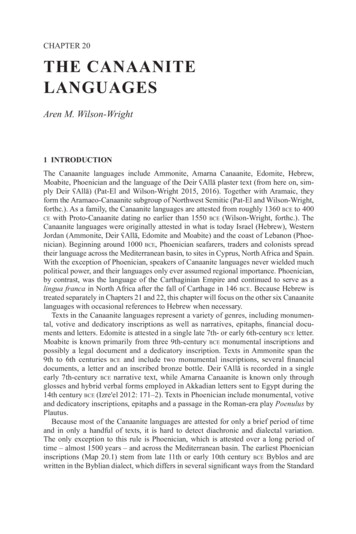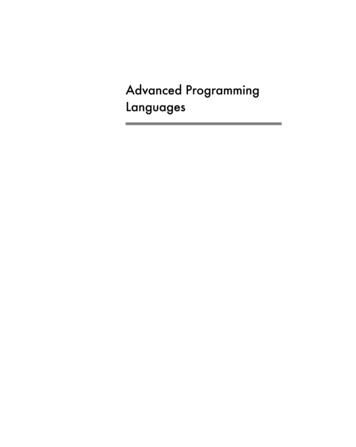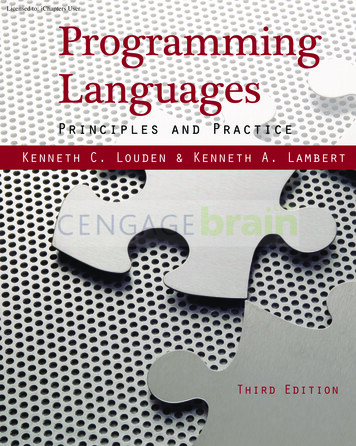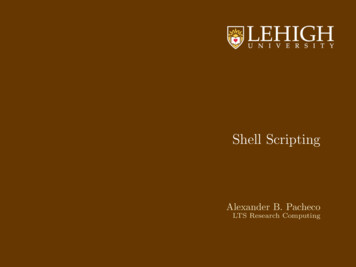
Transcription
CHAPTER 20THE CANAANITELANGUAGESAren M. Wilson-Wright1 INTRODUCTIONThe Canaanite languages include Ammonite, Amarna Canaanite, Edomite, Hebrew,Moabite, Phoenician and the language of the Deir ʕAllā plaster text (from here on, simply Deir ʕAllā) (Pat-El and Wilson-Wright 2015, 2016). Together with Aramaic, theyform the Aramaeo-Canaanite subgroup of Northwest Semitic (Pat-El and Wilson-Wright,forthc.). As a family, the Canaanite languages are attested from roughly 1360 bce to 400ce with Proto-Canaanite dating no earlier than 1550 bce (Wilson-Wright, forthc.). TheCanaanite languages were originally attested in what is today Israel (Hebrew), WesternJordan (Ammonite, Deir ʕAllā, Edomite and Moabite) and the coast of Lebanon (Phoenician). Beginning around 1000 bce, Phoenician seafarers, traders and colonists spreadtheir language across the Mediterranean basin, to sites in Cyprus, North Africa and Spain.With the exception of Phoenician, speakers of Canaanite languages never wielded muchpolitical power, and their languages only ever assumed regional importance. Phoenician,by contrast, was the language of the Carthaginian Empire and continued to serve as alingua franca in North Africa after the fall of Carthage in 146 bce. Because Hebrew istreated separately in Chapters 21 and 22, this chapter will focus on the other six Canaanitelanguages with occasional references to Hebrew when necessary.Texts in the Canaanite languages represent a variety of genres, including monumental, votive and dedicatory inscriptions as well as narratives, epitaphs, financial documents and letters. Edomite is attested in a single late 7th- or early 6th-century bce letter.Moabite is known primarily from three 9th-century bce monumental inscriptions andpossibly a legal document and a dedicatory inscription. Texts in Ammonite span the9th to 6th centuries bce and include two monumental inscriptions, several financialdocuments, a letter and an inscribed bronze bottle. Deir ʕAllā is recorded in a singleearly 7th-century bce narrative text, while Amarna Canaanite is known only throughglosses and hybrid verbal forms employed in Akkadian letters sent to Egypt during the14th century bce (Izre'el 2012: 171–2). Texts in Phoenician include monumental, votiveand dedicatory inscriptions, epitaphs and a passage in the Roman-era play Poenulus byPlautus.Because most of the Canaanite languages are attested for only a brief period of timeand in only a handful of texts, it is hard to detect diachronic and dialectal variation.The only exception to this rule is Phoenician, which is attested over a long period oftime – almost 1500 years – and across the Mediterranean basin. The earliest Phoenicianinscriptions (Map 20.1) stem from late 11th or early 10th century bce Byblos and arewritten in the Byblian dialect, which differs in several significant ways from the Standard
510 Aren M. Wilson-WrightPhoenician used elsewhere in the Levant. Byblian and Standard Phoenician, in turn, differ from the Phoenician used in the Mediterranean basin, which is called Punic after theLatin word for the Phoenicians. Punic used after the fall of Carthage in 146 bce is knownas Late Punic.Despite the poor attestation of several of the Canaanite languages, the unity of theCanaanite family is well established. Six innovative features distinguish the Canaanitelanguages from Aramaic and the rest of Northwest Semitic more generally: (a) the shiftof aː to oː, which triggered (b) the shift of the 1sg independent pronoun from ʔanaːkuː toʔanoːkiː and the 1sg perfective suffix from ‑tuː to -tiː; (c) the generalization of ‑nuː as the1pl suffix to both nominative and oblique positions; (d) the shift of the D stem perfective base from kattib to kittib and the C stem perfective base from haktib to hiktib; (e) asystematic morphosyntactic distinction between two different infinitives (the ‘infinitiveabsolute’ and the ‘infinitive construct’) in the G stem; and (f) a relative marker derivedfrom the noun *ʔaθr- ‘place’ (Huehnergard 1991a, 2006, Pat-El and Wilson-Wright2016).Although the place of Canaanite within the Semitic family is well established, theinternal subgrouping of the Canaanite languages remains murky due to two factors.First, most of the Canaanite languages are poorly attested, making it difficult to knowwhen morphosyntactic innovations are shared among languages. In Standard Phoenician,for example, the C stem suffix conjugation takes the form yktb, which differs from theform hktb found in Amarna Canaanite, Deir ʕAllā, Edomite and Hebrew. At first glance,this form seems to be a good diagnostic feature of Phoenician. Yet the C stem suffixMAP 20.1 THE GEOGRAPHICAL DISTRIBUTION OF CANAANITE INSCRIPTIONS
The Canaanite languages511conjugation is currently unattested in Ammonite, Moabite and Byblian Phoenician, whichmeans that this feature may not go back to Proto-Phoenician and may have been sharedwith Ammonite and Moabite. Second, most of the Canaanite languages are recorded ina purely consonantal script (see §2), which makes it difficult to detect morphosyntacticchanges that affected only vowels.Finally, it is important to note that Amarna Canaanite does not seem to be a directancestor of any of the other Canaanite languages, even though it is attested 300 or moreyears before these other languages. It possesses several distinctive features, such as a3mpl verbal prefix in tV-, that mark it as a separate language.2 WRITING SYSTEMWith the exception of Amarna Canaanite, all of the Canaanite languages are recorded in avariant of the Phoenician alphabet, a script that first emerged in the late 11th or early 10thcentury bce. Over time, the Phoenician alphabet gave rise to two daughter scripts: OldHebrew in the 9th century and Aramaic in the late 8th century bce, which are named afterthe languages that they recorded (note that Northwest Semitic script typology does notreplicate the subgrouping of Northwest Semitic). The Aramaic script, in turn, gave riseto the Transjordanian scripts used to write Ammonite and Edomite. Not every Canaanitelanguage developed its own script, however: Moabite was written in the Old Hebrewscript for all of its recorded history, while the Deir ʕAllā plaster texts were written in avariant of the Ammonite script (Rollston 2010: 19–46). Figure 20.1 contains examples ofsome of the alphabetic scripts used to write the Canaanite languages.The Phoenician script and its descendants originally distinguished 22 consonantal letters but lacked a way to mark vowels. Starting around 900 bce, however, three letterswere co-opted to denote word-final long vowels in the Aramaic and Old Hebrew scripts: h marked final aː and oː, y marked final iː, and w marked final uː. Over time, theletters y and w were used to mark internal long vowels as well. Unlike its daughterFIGURE 20.1 SOME OF THE ALPHABETIC SCRIPTS USED TO WRITE THE CANAANITELANGUAGESDrawing by author.
512 Aren M. Wilson-Wrightscripts, the Phoenician script remained purely consonantal until the 3rd century bce, when ʔ was sporadically used to represent any final vowel and y came to represent finaliː. Later still in the late 2nd century bce the letters ʔ , ʕ , ḥ and h were co-optedto represent additional vowels after the phonemes represented by these letters were lost(Jongeling and Kerr 2005: 7–8): ʔ /o/ /e/ /u/ h /a/ ḥ /a/ ʕ /a/FIGURE 20.2 A 10TH-CENTURY BCE PHOENICIAN ROYAL INSCRIPTION. THE ELIBAALINSCRIPTION (KAI 6) PICTURED HERE IS INSCRIBED ON A BUST OF PHARAOHOSORKON I, WHO RULED OVER EGYPT FROM 924 TO 889 BCEOpen source: Wikimedia.
The Canaanite languages513The use of these letters as vowels gives Late Punic inscriptions a somewhat alien look,with non-etymological “consonants” appearing in the middle of words, e.g., mʕqʔm‘place’ (KAI 124: 2) for earlier mqm.The Canaanite languages are occasionally attested in other writing systems. AmarnaCanaanite was written in cuneiform, and after the fall of Carthage in 146 bce, Punicwas occasionally written in Greek or Latin script due to the loss of scribal facility in theNeo-Punic script.3 PHONOLOGYThe consonantal phonology of the Canaanite languages differs from language to language. Standard Phoenician (Table 20.1) distinguished 22 consonantal phonemes, reflecting the following mergers from the point of view of Proto-Aramaeo-Canaanite:*s, *θ, *ɬ s*ʣ, *ð ʣ*ʕ, * ɣ ʕ*ħ, *x ħ*ʦ’, *θ’, *ɬ’ s’Other languages, by contrast, preserve a more archaic phonemic repertoire. Greek transcriptions of Hebrew, for example, show that Hebrew maintained the distinction between*ɣ and *ʕ and between *x and *ħ until the 1st or 2nd century ce (Steiner 2005: 266).1Hebrew also maintained the voiceless lateral fricative *ɬ, which is distinguished from *s ʃ in the orthography of the Hebrew Bible by the use of diacritics ( [ שׁ ʃ] and [ שׂ ɬ]).A Neo-Assyrian transcription of the Moabite personal name kmš-ʕšh as ka-ma-aš-ḫal-tasuggests that Moabite also preserved *ɬ (Knauf and Maani 1987: 93). And finally, thedifferent outcomes of *ɬ’ in Deir ʕAllā compared to the rest of the Canaanite languagesshows that *ɬ’ was a distinct phoneme in Proto-Canaanite. In the orthography of the DeirʕAllā inscription, the ejective lateral fricative *ɬ’ is represented with q , which suggeststhat *ɬ’ had either merged with k’ or shifted to a phoneme similar enough to k’ (kχ’?) thatit could be represented with the letter for k’. In the other Canaanite languages, by contrast,*ɬ’ merges with *s’ and *θ’. Based on these survivals, Proto-Canaanite can be reconstructed with 26 consonantal phonemes, which are summarized in Table 20.2.Even though most of the Canaanite languages were written in consonantal orthography, we can glean information about the vocalic systems of the Canaanite languages usingthe comparative method, orthographic anomalies and transcriptions of some CanaaniteTABLE 20.1 THE CONSONANTAL PHONEMES OF STANDARD PHOENICIANMannerBilabial Dental Lateral Palatal Alveolar-Palatal Velar Pharyngeal nts wt d t’nr ʦ ʣ ʦ’ljk g k’ħʕʔh
514 Aren M. Wilson-WrightTABLE 20.2 THE CONSONANTAL PHONEMES OF PROTO-CANAANITEMannerBilabial Dental Lateral Palatal Alveolar-Palatal Velar Pharyngeal nts wt d t’nrɬ ɬ’sljʦ ʣ ʦ’k g k’xɣħʕʔhTABLE 20.3 THE OUTCOME OF THE DIPHTHONGS IN THE CANAANITE LANGUAGES*aj*awAmmoniteDeir ʕAllāEdomiteMoabitePhoenicianeːawajawajaw oːaj eːaw oːeːoːlanguages in cuneiform, Greek and Latin. The Canaanite family’s immediate ancestor,Proto-Aramaeo-Canaanite, possessed six vocalic phonemes – a, i, u and their long counterparts aː, iː, uː – and two diphthongs, *aj and *aw. In Proto-Canaanite, however, thephonemic opposition between long and short vowels began to disintegrate with the shiftof *aː oː. Although this type of shift is typologically common and even occurred in thehistory of English, Semitists refer to this change as the Canaanite shift. Amarna Canaanite seems to preserve the inherited Canaanite system of vowels. In other languages, bycontrast, one or both of the diphthongs contracted. In Edomite, the contraction of awto oː occurred in the historical period, sometime between the 7th and 6th centuries bce,and in Moabite, the diphthongs were in the process of collapsing during the 9th century(compare bt [beːt] ‘house’ in KAI 181:7, 23 with byt [bajt] ‘house’ in KAI 181:25).Table 20.3 summarizes the outcome of the diphthongs in the Canaanite languages whereattested.Only in the case of Phoenician do we possess adequate data to detect significant diachronic changes in phonology. These data show that the already diminished Phoenicianconsonantal system underwent further reductions and modifications in the last centuriesof the first millennium bce. In the 2nd century bce, Punic lost ʔ, h, ʕ and ħ. Around thesame time the voiceless stops p, t and k underwent spirantization to f, θ and x; w shifted tov and b shifted to w; and θ was lost in the word-final position. In contrast to the upheavalin the inventory of “gutturals” and stops, the affricates ʦ, ʣ and ʦ’ remained stable, atleast in the Late Punic spoken in North Africa. The use of the Greek letter ζ to write ʣand a ligature of T and S to write ʦ’ in Latin transcription suggests that these consonantsretained their affricated pronunciation. This state of affairs stands in contrast to Hebrew,where the affricate ʦ shifted to s during the 7th century bce (Wilson-Wright, forthc.).Phoenician vowels also underwent radical changes from the perspective ofProto-Canaanite. Already in the earliest inscriptions, the diphthongs *aj and *aw contracted to eː and oː respectively, and the latter vowel merged with the oː produced by theCanaanite shift. By the Hellenistic period, the product of this merger was raised to uː:χουσωρ [kuːsor] *kawθar (PE 1.10.11). Around the 8th century bce short, accenteda shifted to o in originally open syllables, a sound change that Semitists refer to as the
The Canaanite languages515Phoenician shift: ḫi-ru-um-mu [ħiːrom] *ʔaħiːrám (Annals of Tiglath-Pileser 27, ln.2, Fox 1996: 38–41). Similarly, short, accented i shifted to eː in originally open syllables during the Hellenistic period (βαλσιλληχ [baʕl-silleːk] *baʕl-sillík ‘Baal has sent’[CIL VIII 16]), while unaccented i shifted to ε in originally open syllables (Γεραστρατος[gεr-ʕaštart] *gir-ʕaštart ‘client of Astarte’ [Contra Apion 1, 157]). In all other positions, short i was retained. By the Hellenistic period, Phoenician distinguished the following vowels: a, eː, ε, i, iː, o, u and uː.Ultimately, these changes disrupted the inherited opposition between long and shortvowels, and, eventually, vowel length ceased to be phonemic in Punic (Kerr 2010: 106).Instead, vowel length came to be conditioned by stress: stressed vowels were long (evenif they were historically short), while unstressed vowels were short (even if they werehistorically long), and tended to reduce to schwa. These developments can be seen especially clearly in the inherited 1st person independent pronoun *ʔanoːkiː, which is writtenanech [anəx] in the Poenulus. The historically short a vowel in the first syllable wasaccented and therefore retained, while the historically long vowels oː and iː reduced toschwa and, in the case of iː, disappeared entirely.Syllables in the Canaanite languages could take the form CV, CVC and CVː. According to the available data, this restriction on syllable type remained historically stable inall of the Canaanite languages.4 MORPHOLOGY4.1 PronounsThe Canaanite languages employed two series of personal pronouns: independent andsuffixed. The independent forms were primarily used for the nominative and occasionallyto topicalize suffixed forms, while the suffixed forms marked nominal possession andserved as the object of finite verbs. The suffixed forms could also act as the subject of aninfinitive as in the following example from Moabite:b-hltḥm-hb-yin-fight.refl. inf.cst-3msgin-1sg‘when he was fighting me’ (KAI 181:9)Only the 1sg suffix pronoun distinguished between post-verbal (i.e., accusative) andpost-nominal (i.e., genitive) forms. Tables 20.4, 20.5 and 20.6 summarize the personalpronouns in the Canaanite languagesMost of the suffixed pronouns remained relatively stable across languages. The 3sgsuffix pronouns, however, underwent several ad hoc changes in different languages anddialects. Interestingly, these changes often presume different phonetic environments,reflecting different relics of the Northwest Semitic case system. The Byblian 3msg forms ‑w and ‑ø reflect syncope of original -huː before the a vowel of the accusative (-ahuː -auː -aw -oː) as do Standard Phoenician ‑ø , Punic -ʔ and Late Punic [‑oː]. The3fsg forms ‑ø , -ʔ and [‑aː] probably derive from a similar sound change. StandardPhoenician 3msg and 3fsg -y reflects palatalization of h following the i vowel of thegenitive: -ihuː -ijuː and -ihaː -ijaː (Huehnergard 1991b: 187). And the Late Punic3msg suffix -m has been explained in several ways. Huehnergard (1991b: 189–90)sees it as a rendering of [‑iw], which would have been phonologically similar to [‑im]
TABLE 20.4 THE INDEPENDENT PRONOUNS IN THE CANAANITE lianPhoenicianStandardPhoenicianLate [u]hʔhʔ, ʔanoːkiː]hʔhmTABLE 20.5 THE SUFFIXED PRONOUNS IN PHOENICIANByblian /Von verbs/C/V/aj/C/V/aj-h, -w/C/V/C/V-hm-w-hStandard Phoenician-ø, -y-y-n-k-k-ø-y-y-ø-y-y-nPunicLate Punic-ʔ[-oː], m]TABLE 20.6 THE SUFFIXED PRONOUNS IN THE REST OF THE CANAANITE LANGUAGESAmarna Canaanite1sg2msg2fsg3msg3fsg1pl2mpl2fpl3mpl3fplon nounson verbson mpl nounsAmmoniteDeir h-k-ky-h-wh-km-hm, -m-kMoabite-y-ny-h-h-h-km
The Canaanite languages517in Late Punic and would reflect h syncope before the genitive: ‑ihuː -iuː -iw. Kerr(2010: 141), by contrast, relates it to the obscure 3sg pronoun -moː occasionally found inHebrew (e.g., Genesis 9:26, Deuteronomy 33:2).The 3msg suffix also exhibits several idiosyncrasies when attached to masculine pluralnouns. In Deir ʕAllā, the masculine plural bound morpheme ‑aj undergoes partial assimilation to the vowel of the 3msg suffix, leading to ‑awhuː, written -wh . In StandardPhoenician, by contrast, the h of the 3sg suffixes assimilates to the eː of the constructmorpheme: -eːhuː -eːjuː and -eːhaː -eːjaː. Byblian ‑w probably reflects partialassimilation of the bound morpheme to the vowel of the suffix, followed by syncope ofthe h: -ajhuː -awhuː -awuː.The Phoenician 3m pronouns exhibit several other quirks. The Byblian 3msg independent pronoun hʔt and the Standard Phoenician 3mpl and 3fpl independent pronouns hmtreflect oblique forms of the 3m independent pronouns inherited from Proto-Semitic. Theorigin of the distinctive Standard Phoenician, Punic and Late Punic 3mpl suffix pronoun-noːm is debated. Huehnergard (1991b: 191–4) derives the unexpected nasal element ofthis suffix from the old 3mpl indicative prefix ending ‑uːnaː: *yaktubuːna-hum *yaktubuːnawm yaktubuːnoːm, which was then reanalyzed as yaktubuː-noːm by comparisonwith the usual 3mpl prefix form yaktubuː. Kerr (2010: 143), on the other hand, derives-noːm from -Vn-humu, where -Vn- is the nasal infix occasionally used with prepositions.In Phoenician, the 1sg and 3pl suffixed pronouns have two allomorphs whose usageis conditioned by phonetic environment. The forms ‑ø and ‑m appear after a consonant, while the forms ‑y and ‑nm appear after a vowel. This distinction demonstrates that a reduced case system was still operative in Phoenician: nouns in the genitivetake the prevocalic forms, while nouns in the nominative and accusative bear the preconsonantal forms, which indicates that genitive nouns in Phoenician still ended with an ‑i.The Late Punic 2mpl possessive suffix takes the form [-ʔom] following the spirantization of the velar stop and the loss of the voiceless velar fricative, e.g., *-kumu *-xum [-ʔom].4.2 DemonstrativesThe Canaanite languages possessed two series of demonstrative pronouns, proximal anddistal. The proximal series followed a suppletive paradigm, employing a z base in thesingular and an ʔl base in the plural, and only distinguished gender in the singular. In LatePunic, the feminine singular proximal demonstratives underwent devoicing, most likelydue to the presence of the final ‑t. This devoicing then spread to the masculine forms. Forthe most part, the distal pronouns are identical to the 3rd person independent pronouns.Table 20.7 summarizes the various proximal demonstratives attested in Phoenician, theTABLE 20.7 THE PROXIMAL DEMONSTRATIVES IN THE VARIOUS DIALECTS OFPHOENICIANmsgfsgplByblian PhoenicianStandard PhoenicianPunicLate Puniczn, zzʔt, zʔʔlzzʔlz, s, stzt, stʔlʔ[sə][səθ][illə]
518 Aren M. Wilson-Wrightonly Canaanite language other than Hebrew to preserve the full paradigm. Outside ofPhoenician, Moabite attests to the fsg proximal demonstrative zʔt (KAI 181:3).4.3 InterrogativesIn contrast to the rest of the pronominal system, the interrogative pronouns were markedfor animacy (animate vs. inanimate) rather than person-gender-number. The animateinterrogative appears in Punic as mi [miː] ‘who?’ (Poen. 1010) and in Amarna Canaaniteas mi-ya [mija] ‘who?’ (EA 85:63; 94:12; 116:67). Amarna Canaanite also possessed anoblique form of the animate interrogative in [mijatiː] (EA 220:11). The final -atiː on thisform is most likely the oblique morpheme ‑t found on the Byblian 3msg independentpronoun hʔt and the Standard Phoenician 3mpl independent pronoun hmt. The inanimateinterrogative *mah ‘what?’ appears in Deir ʕAllā (I, 5), Hebrew (Genesis 2:9 inter alia)and Punic (Poen. 1010) and came to be employed as a relative particle in Late Punic.Deir ʕAllā also possessed a compound interrogative l-m ‘why’ (literally ‘for what?’). InStandard Phoenician, both interrogatives could serve as indefinite pronouns, e.g., w-myyšḥt h-spr z ‘and whoever destroys this inscription’ (KAI 24:14), mʔš pʕlt ‘whatever I did’(KAI 24:4).4.4 RelativeAlthough both Byblian Phoenician, Late Punic and Archaic Hebrew preserve vestigesof the inherited Northwest Semitic relative pronoun *zVː, all of the Canaanite languagesuse a grammaticalized form of the noun *ʔaθr ‘place’ as a relative particle (Pat-El andWilson-Wright 2016: 44–7). This particle grammaticalized differently in the various languages. In some, it retained its full morphological form; in others, it reduced to ʔš or evento a clitic š with gemination in the following consonant (Huehnergard 2006: 124–5). Inaddition to forms derived from *ʔaθar and *zVː, Late Punic also possessed a third relativemarker, mu, derived from the inanimate interrogative pronoun *mah ‘what?’. Table 20.8summarizes the different forms of the relative marker in the Canaanite languages.4.5 Nouns and adjectivesNouns and adjectives in the Canaanite languages were declined for gender (masculineand feminine), number (singular, plural and rarely dual), state (bound or nonbound)TABLE 20.8 THE VARIOUS FORMS OF THE RELATIVE MARKER IN THE llāEdomiteMoabiteʔš, šʔšʔšrʔšrByblianzStandardPhoenicianLate Punicʔš[əʃ][zə][mu]
The Canaanite languages519and in some instances, case (nominative or oblique). As in Semitic in general, nounsin the Canaanite languages could be bound (i.e., dependent on a following nominal,verbal clause or prepositional phrase) or nonbound (i.e., independent). Bound and nonbound nouns took the same form in the singular in the Canaanite languages, but theplural employed different morphemes to distinguish bound and nonbound forms. SomeCanaanite languages preserved vestiges of the Northwest Semitic case system, which distinguished nominative, genitive and accusative cases in the singular and nominative andoblique cases in the plural. Phoenician preserved a distinction between the nominativeand oblique case in the singular before the 1sg and 3rd person suffixes, while AmarnaCanaanite preserved a general distinction between the nominative and oblique cases in theplural: mar-ia-nu-ma [maryanuːma] ‘chariot warriors (nom)’ (EA 107:43) and li-mi-ma[liʔmiːma] ‘peoples (obl)’ (EA 205:6). Table 20.9 summarizes the nominal declensionsof the various Canaanite languages.With the exception of Amarna Canaanite and Deir ʕAllā, all of the Canaanite languages feature a prefixed definite article derived from the presentative particle *han-:Ammonite h-krm ‘the vineyard’ (KAI 308:4); Edomite h-ʔkl ‘the food’ (Ḥorvat Uza ln.3); Moabite h-ʔrṣ ‘the land’ (KAI 181:29); Phoenician h-btm ‘the houses’ (KAI 4:2).In most cases, the n of the definite article assimilated to the following consonant. Theresulting doubling usually remains undetectable in the purely consonantal orthography ofthe Canaanite languages, but several unusual Punic spellings confirm its presence, e.g.,ʕm-mqm [am-maquːm] ‘the place’ (KAI 173:5), as does the vocalization of the HebrewBible, [ham-mɔjim] ‘the water’ (Genesis 1:2).4.6 NumeralsApart from Hebrew, Phoenician preserves the best evidence for the numerals, which werearranged in a decimal system. The units were nouns and declined for gender, with feminine forms invariably taking a final -t (Table 20.10). The tens were formed by addingthe plural morpheme to the corresponding unit, with the exception of ‘twenty’, whichwas the plural of ‘ten’. Separate words for ‘hundred’ (mʔt) and ‘thousand’ (ʔlp) are alsoattested. Composed numbers took the form hundreds and tens and ones, e.g., mʔt w-šlšmw-šlš ‘133’ (KAI 130:2). In Late Punic, the units could take a pronominal suffix to referto groups, e.g., ʔrbtnm ‘the four of them’ (IPT 79:5). The existence of this constructionTABLE 20.9 THE NOMINAL DECLENSIONS OF THE CANAANITE LANGUAGESmsgmplnbndmplAmarnaCanaaniteAmmoniteDeir ʕAllā EdomiteMoabiteStandardLate n-ø-m[-ø][-iːm]-ø-y-ø, ][-eːm]
520 Aren M. Wilson-WrightTABLE 20.10 THE UNITS IN PHOENICIAN12ʔ45678910MasculineFeminineʔḥdšnm (nbnd)šn (bnd)šlšʔrbʕḥmššššbʕšmnh �tʕšrtsuggests that numerals stood in construct with the noun that they modified. Ordinal numbers were formed in Phoenician with the addition of a final ‑y (e.g., ʔrbʕy ‘fourth’ in KAI76B:1), which can probably be vocalized [‑iːj] on the basis of Hebrew.Outside of Phoenician the evidence for the number system is slim: ‘one’ (ḥd) appearsonce in Deir ʕAllā (II, 10), ‘seven’ (ši-bi or ši-bi-i/e) occurs several times in AmarnaCanaanite (EA 196:4, 211:4, 215:6), and the numbers ‘30’ (šlšn), ‘40’ (ʔrbʕn), ‘100’ (mʔt),‘200’ (mʔtn) and ‘7,000’ (šbʕt ʔlpn) show up once each in Moabite (KAI 181:2, 8, 16, 20,29); the texts in Ammonite and Edomite do not contain any numerals.4.7 VerbsVerbal morphology in the Canaanite languages, as in the Semitic languages in general,was particularly rich. Verbal roots occurred in two finite conjugations – prefix and suffix – and a variety of stems, which altered the semantics of the underlying root. Each stemalso possessed its own infinitive, participle and imperative forms. In Proto-Canaanite atleast, the basic stem distinguished between two morphologically and syntactically distinct infinitives.The Canaanite languages inherited a complex TAM system from Central Semitic thatdistinguished between three prefix conjugations: an imperfective yaktubu yaktubuːnaform, a preterite/jussive yaktub yaktubuː form, and a cohortative yaktuba yaktubuːform. Any of the three prefix conjugations could be marked additionally with the suffix‑(n)na (the so-called energic suffix), whose function is still poorly understood. AmarnaCanaanite still retains this system largely intact, which is summarized using a G stemverb in Table 20.11. In the remaining languages, however, the morphological distinction between the three forms collapsed due to the loss of final short vowels: *yaktub,*yaktubu, *yaktuba yaktub. The loss of distinctiveness in the singular, in turn, led toleveling in the plural form: Standard Phoenician and Deir ʕAllā leveled the jussive form,while Ammonite probably leveled the imperfective form. Despite this loss of morphological distinctiveness, the later Canaanite languages still preserved a regular semanticdistinction between the imperfective and jussive forms. The prefixed preterite form, however, was restricted to certain syntactic environments, with the suffix conjugation being
The Canaanite languages521TABLE 20.11 THE THREE PREFIX CONJUGATIONS OF AMARNA buːnVktVbatVktVbaːTABLE 20.12 THE SUFFIX CONJUGATION IN AMARNA CANAANITE, STANDARDPHOENICIAN AND LATE rna CanaaniteStandard PhoenicianLate ][kataltunu][katabuː][katob][kataba][katabaː]the preferred means of expressing the past tense. Hebrew, Moabite and Deir ʕAllā preserve the preterite form as a narrative tense to describe consecutive actions. Interestingly,Amarna Canaanite differs from Phoenician, Hebrew, Moabite and Ammonite in usingtV- as the 3mpl prefix. The 3mpl prefix form is unattested in Edomite.The suffix conjugation is far simpler than its prefix counterpart. Historically, it derivesfrom the Proto-Semitic stative, a verbal adjective marked with enclitic pronouns, whichdeveloped into a perfective conjugation in West Semitic (see Chapter 3, §3.5.4). In theCanaanite languages, it acts as perfective form and, with certain roots, can have a stative meaning. Table 20.12 summarizes the forms of the G stem suffix conjugation inAmarna Canaanite, Standard Phoenician and Late Punic, the three languages where it isbest attested.In addition to the conjugation system, the Canaanite languages distinguished at leastfour verbal stems (G, D, C, N), which rang morphological and semantic changes on the
522 Aren M. Wilson-Wrightverbal root. The Ground stem (G), whose finite forms are summarized above, was thebasic form of the verb. The Doubled stem (D) was marked by doubling of the middleradical of the verbal root in all derived forms (kittib yukattib). The semantic effectof this stem is hard to quantify. In general, it tends to raise the valence of the verbalroot by one and, therefore, is often referred to as a factitive stem. It is also used to formdenominal verbs. The Causative stem (C) is marked by a prefixed hV-, which elided inthe prefix conjugation (hiktib yaktib). In Sta
3mpl verbal prefix in tV-, that mark it as a separate language. 2 WRITING SYSTEM With the exceptio n of Amarna Canaanite, all of the Canaanite languages are recorded in a variant of the Phoenician alphabet, a script that first emerged in the late 11th or early 10th century bce. Over time, the Phoenician alphabet gave rise to two daughter .










